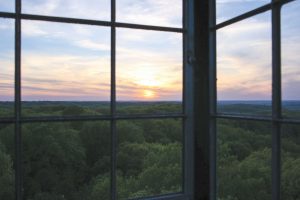Subscriber Benefit
As a subscriber you can listen to articles at work, in the car, or while you work out. Subscribe NowThe Hoosier National Forest, which covers several counties in the southern part of the state, has been the focus of two lawsuits since 2020 aimed at stopping a controversial federal vegetation management plan that involves the logging and burning of several thousand acres within the forest.
One lawsuit has been appealed by both parties but has remained dormant on the 7th Circuit Court of Appeals’ docket since 2022.
But a second lawsuit saw a quicker resolution, with a federal judge issuing a preliminary injunction in March preventing the U.S. Forest Service from moving forward with its management plan.
Now, the forest is also the subject of federal legislation, proposed by one of Indiana’s U.S. senators, that would significantly expand the forest and aim to provide better protection of Lake Monroe’s water quality.
Waiting game
The Monroe County Board of Commissioners and others filed the first lawsuit — Monroe County Board of Commissioners, et al. v. United States Forest Service, et al., 4:20–cv–106 — in 2020 challenging the Houston South Vegetation Management and Restoration Project.
The Houston South Project would have involved the logging of 4,000 acres, burning of 13,500 acres and the application of herbicide to nearly 2,000 acres over the course of 12 to 20 years, without performing an environmental impact assessment.
The Monroe County Board of Commissioners, Indiana Forest Alliance, Hoosier Environmental Council and Friends of Lake Monroe were concerned about the project for a number of reasons, particularly the impact the project could have on Lake Monroe, which is the sole drinking water source for more than 128,000 customers in Monroe County and provides supplements to other water sources in Brown County, as well.
In their lawsuit, the county commissioners alleged the project violated the National Environmental Policy Act by not considering alternatives to the project and the Endangered Species Act by not assessing the project’s effect on the Indiana bat and other endangered species.
The U.S. Forest Service responded to the complaint by requesting dismissal with prejudice. It claimed that the plaintiffs failed to state a claim for which relief may be granted, and that an injunction would have been inappropriate.
Chief Judge Tanya Walton Pratt of the U.S. District Court for the Southern District of Indiana ruled in 2022 that the planned project didn’t violate federal laws but ordered the U.S. Forest Service to evaluate the project’s impact on Lake Monroe and explain why it would not be significant.
Bill Eubanks, the attorney for the plaintiffs, said the partial win was great, but they weren’t fully satisfied.
“The biggest concern was the water quality issues, because all of these sediments that are going to be sitting on these steep slopes are going to drain down into Lake Monroe,” Eubanks said. “There are a lot of wildlife concerns, recreational concerns, a lot of other concerns, but if I had to pinpoint sort of the most important issue here from a public health standpoint, it was what will happen once you take all of those trees and their roots out of the soil and essentially expose the steep slopes to sedimentation and erosion issues, which would all have a whole bunch of toxic ash from the burning, as well.”
The Forest Service performed a review of the existing environmental assessment instead of performing a new assessment. That decision, it said, was due to timeliness issues. It also said the agency believed the project would not negatively impact Lake Monroe water quality.

Both parties appealed the order to the 7th Circuit Court of Appeals, where they were faced with a jurisdictional question.
That was resolved when both parties agreed on the jurisdiction, but the case has been sitting since. The last docket entry was Dec. 9, 2022.
Eubanks, who practices in several states’ federal courts, said it’s not common for a case to just sit on federal appeal, and he has never seen it happen before.
“In my experience of being involved in dozens of federal appeals, I’ve never seen a situation like this. It’s quite rare,” he said.
Eubanks added that there have been discussions about filing something to get the case moving, but neither party has done so at this time.
Injunction issued
The second lawsuit — Monroe County Board of Commissioners, et al. v. United States Forest Service, et al., 4:23-cv-00012 — was filed in January. That case also challenged the Houston South Project.

Eubanks said the plaintiffs had hoped they could work it out to where they didn’t have to request a preliminary injunction, but they weren’t able to reach an agreement with the U.S. Forest Service.
“They were no longer willing to work with us on that. They didn’t provide that courtesy,” he said.
Pratt presided over that case, as well, and in March she granted a preliminary injunction preventing the U.S. Forest Service from continuing its Houston South Project until an assessment is conducted.
The Forest Service decided not to appeal the ruling.
“They withdrew their supplemental information report after we won and paid our attorneys fees,” Eubanks said. He added that it is rare to get a preliminary injunction against a federal governmental agency.
David Van Gilder, the senior policy and legal director for the Hoosier Environmental Council, agreed with Eubanks and called the ruling “extraordinary.”
Eubanks said the litigation has set the Huston South Project back three years.
The U.S. Forest Service recently came out with scheduled proposed actions, Van Gilder added. He said he hadn’t had a chance to look at them yet, but they’re the same name as the plan they had challenged.
“So basically the Forest Service guys got spanked, and now it looks like they’re coming back with an environmental assessment with a new plan or a different plan,” Van Gilder said.
The new listing with the same name as before describes the project as proposing “to treat vegetation and conduct related management activities improving forest health and sustainability of the oak-hickory ecosystems while also improving wildlife habitat.”
Van Gilder said what matters is that the law is followed.
“When you’re managing a national forest as a resource, that’s actually public land that is a resource that all of us own and share. So I think what’s really important is that sometimes these kinds of fights get characterized as environmentalists versus so and so, but it really boils down to who is actually doing the work to protect the public trust,” he said.

Van Gilder also said they’re keeping an eye on the U.S. Forest Service and are prepared to go back to court if needed.
The U.S. Forest Service declined to comment on pending litigation, citing the 7th Circuit case.
Legislative efforts
Meanwhile in Congress, Sen. Mike Braun, R-Indiana, recently introduced legislation that would expand the Hoosier National Forest.
“Indiana is blessed with natural beauty, outdoor recreation, and history in every corner of the state,” Braun said in a news release. “As an avid outdoorsman who knows the importance of conservation, I’m proud to introduce legislation that will specifically designate thousands of acres of forest for protection in Indiana to ensure it can be enjoyed and appreciated by future generations.”
The bill, S. 2990, otherwise known as the Benjamin Harrison National Recreation Area and Wilderness Establishment Act of 2023, would designate about 15,300 acres to expand the forest and the Charles C. Deam Wilderness area, and about 29,382 acres for the designation of a National Recreation Area to serve as subunits of the forest.
The bill also includes protection of Monroe Reservoir water quality.

Jeff Stant, executive director of the Indiana Forest Alliance, said he worked with Braun and his team on the legislation for two years.
Stant said he hopes the legislation modifies the Houston South Project plans.
“They’ll have to comply with what will be statutorily mandated to manage those very acres to protect the public water supply of Lake Monroe and promote recreation instead of trying to produce crop trees for the timber industry,” he said. “Every acre that’s in the (Houston South) Project would be absorbed into the Benjamin Harrison National Recreation Area.”
Stant added that the area, with the expansion, will be the largest area of wild forest in the lower Midwest. It is home to the only population of endangered timber rattlesnakes and several species of bats and birds.
“There’s a lot of rare and endangered species that depend on this,” Stant said.
The legislation has been referred to the Senate Committee on Agriculture, Nutrition, and Forestry.•
Please enable JavaScript to view this content.
